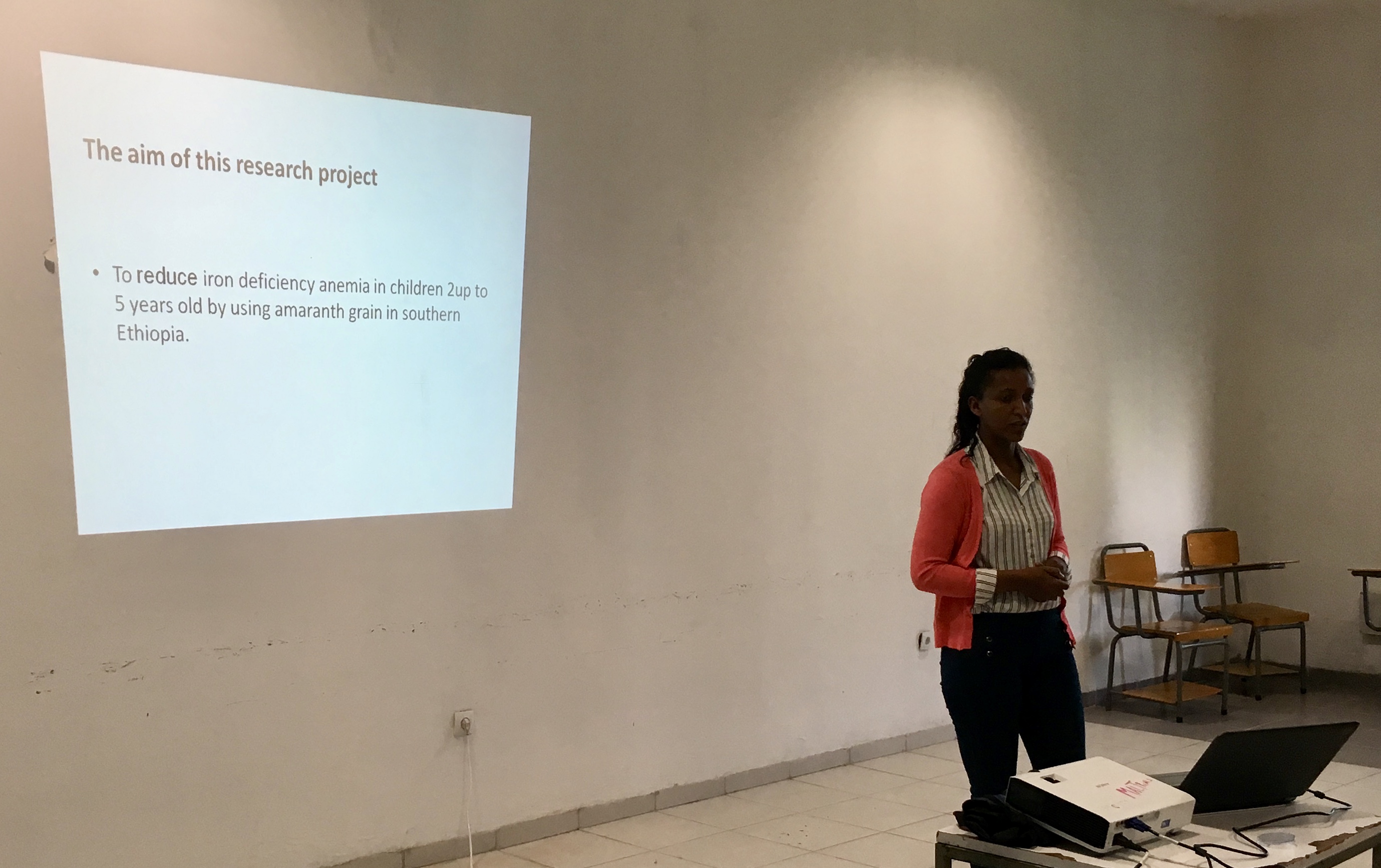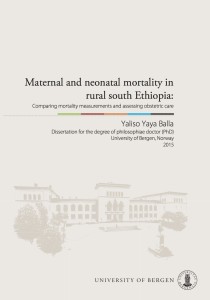On May 30th, 2013, Adugna Woyessa defended his PhD thesis at Addis Ababa University. The PhD thesis The epidemiology of highland malaria in Ethiopia: a study from Butajira area aims to describe human malaria transmission in rural south central Ethiopian highlands.
Abstract
Background:In Ethiopia, malaria is a major public health problem with seasonal and unstable distribution. Because of the country’s diverse topography and climate, transmission of malaria varies with space and time; while the variability is more pronounced in highlands with low transmission. This calls for better understanding of malaria. However, there is paucity of information on magnitudeof malaria, risk factors, effective use of vector control measures such as insecticide-treated nets in relationship with malaria infection and performance of multi-species detecting malaria rapid diagnostic tests (RDTs) where Plasmodium falciparum and Plasmodium vivax co-exist at highlands of low-endemicity.
Objectives:To describe the epidemiology of highland malaria with emphasis to the magnitude and associated factors as well as interventions in various altitudesof Butajira area, south-central Ethiopia.
METHODS: Community-based repeated cross-sectional studies were conducted in six rural kebeles of Meskan and Mareko Districts from October 2008 to June 2010in Butajira area, Ethiopia. The kebeles (Hobe, Bati Lejano, Dirama, Shershera Bido, Yeteker and Wurib) were selected in such a way that two were from one altitudinal stratum thus making a total of three strata: low (1,800-1,899 meters above sea level), mid-level (1,900-1,999 meters above sea level), and high (2,000-2,300 meters above sea level) altitudes. These kebeles are part of Demographic Surveillance System Site of the Butajira Rural Health Program). A multi-stage sampling method was used to recruit study participants. The various stages were kebeles as first-stage, villages as second-stage, and households as third-stage units. A total of 3,393 individuals were recruited from randomly sampled 750 households in 16 villages. Probability proportion to size sampling method was applied to allocate the number of households to be sampled from each kebeleand village. The study obtained data from household interview, survey and recruiting all self-reported febrile cases. Household interview was undertaken by trained data collectors using pre-tested structured questionnaire. Household altitude reading and geo-reference was recorded from geographical positioning system location. Seasonal blood surveys were made on quarterly basis between Oct. 2008 and Jun. 2010. From the sampled households, all family members who consented to participate were requested for blood films. Besides, self-reported febrile cases were simultaneously checked for malaria infection using RDTs. CareStartTMMalaria Plasmodium falciparum/ Plasmodium vivax combo test result was compared with microscopy. Analytical tools including descriptive statistics, multilevel analysis, principal component analysis, and complex sample analysis were employed.
Main findings: The unadjusted prevalence of malaria was found to be 0.93 % [95% CI 0.79-1.07]; of 19, 207 people, 178 were positive; adjusted prevalence of malaria was estimated at 0.78 (95% CI: 0.48-1.29); of 19, 199 people, 178 were positive. Plasmodium vivax was dominant (86.5%, n=154) and the rest of the cases were due to Plasmodium falciparum (12.4%, n=22, seven with gametocyte) and mixed infections (1.1%, n=2).The prevalence varied among villages with the highest prevalence of 2.8% in Dadesso and Horosso villages (both <1,850 masl), and the lowest prevalence of 0.0% in Sunke Wenz and Akababi village (2,100-2,180 masl). Malaria prevalence decreased with altitude: 1.91% [95% CI (1.55-2.27)] in low, 1.37% [95% CI (0.87-1.87)] in mid-level and 0.36% [95% CI (0.25-0.47)] in high altitude zones; the highest prevalence was found at low altitude between October and November 2009. Moreover, malaria varied among age groups and the variation was different at different at altitudes. It reached its peak in children aged one to four yearsYonkers at mid-level and one to nine years at low altitudes. However, its prevalence at higher altitude was low and was similar across all age groups. Plasmodium falciparum malaria occurred rarely throughout the survey periods, with relatively more cases in October-November 2009 in the low altitude zone. Plasmodium vivax was found in all survey periods. However, its prevalence differed with respect to survey period and altitude. Variables like age (children aged below five and 5-9 years), altitude (low and mid-level altitude), and in houses with holes as individual-level factors; and village-level variables explained most of the variation (ICC= 94%) in individual malaria infection. The estimates of village-level variances showed well marked differences in malaria infection.
Only 28.5% [95%CI 25.8-31.4] of the 739 households surveyed owned at least an ITN. Household ITN ownership was associated with household heads with no formal education, male-headed households, more beds in the house, absence of mosquito source reduction, and nonexistence of main water body. Male-headed households were also more associated with increased ITN ownership than female-headed ones. Households with ITN observed hanging, two and more number of ITN owned, not doing source reduction and less than a kilometredistance from main water body showed high association with use of ITN while the presence of more ITN observed hanging was a good predictor. Higher prevalence was found among people surveyed from ITN-owning than non-ITN-owning households (2.1% versus 0.5%). Malaria infection was more often observed in households owning at least an ITN than in their counterparts (unadjusted OR 4.1 [95% C.I. 2.2-7.6]; F (1, 22) =25.2, P<0.001).
Data obtained from a total of 2,394 self-reported febrile cases: 66.8% (n=1,598) from health facilities and the rest 33.2% (n=796) from surveys. Higher proportionof Plasmodium positives and both Plasmodium falciparum and Plasmodium vivaxwere detected at health facilities compared to what was seen in the survey. However, more mixed infections were observed in the latter. Low sensitivity of the test was observed in all Plasmodium species (90.8%, 95% CI: 82.9-95.3), and Plasmodium falciparum (87.5%, 52.9-97.8) in survey; and Plasmodium vivax (92.8%, 95% CI: 89.3-95.2) at health facilities. Low specificity of Plasmodium vivax (87.5%, 95% CI: 52.9-97.8) was found at the survey and all Plasmodium species (82.7%, 95% CI: 80.5-84.8) at health facilities. Very low PPV was detected in all Plasmodium species (76.7%, 95% CI: 67.7-83.8), and Plasmodium falciparum (87.5%, 95% CI: 52.9-97.8) at the survey and all Plasmodium species (64.3%, 95% CI: 60.5-68.1) and Plasmodium falciparum (77.2%, 95% CI: 67.6-84.5) at health facilities. Low NPV was observed in Plasmodium vivax both in the survey (87.5%, 95% CI: 52.9-97.8) and health facilities (77.2: 67.6-84.5).The measure of agreement or kappa score was almost perfect agreement in all categories, except in all Plasmodium species with substantial agreement.
Conclusions and recommendations: This thesis demonstrates that low prevalence of malaria with age and altitude dependent distribution was found in highlands with low transmission in south-central Ethiopia. Plasmodium vivax was the dominant species more prevalent throughout the survey. There was very low ITN use that might have also hardly protected children in ITN-owning households. Performance of malaria RDT detecting Plasmodium falciparum and Plasmodium vivax vary between health facility-based and survey setting for both species. A malaria intervention that prioritises children below 10 years appears to be practically feasible to reduce malaria transmission. Strengthening surveillance to help in evidence-informed decision of vector control is recommendable. Furthermore, future studies should target designing more frequent survey and application of PCR for evaluation of RDT performance.
Publications:
Woyessa A, Deressa W, Ali A, Lindtjorn B. Ownership and use of long-lasting insecticidal nets for malaria prevention in Butajira area, south-central Ethiopia: complex samples data analysis. BMC public health 2014; 14: 99.
Woyessa A, Deressa W, Ali A, Lindtjørn B. Evaluation of CareStartTM malaria Pf/Pv combo test for Plasmodium falciparum and Plasmodium vivax malaria diagnosis in Butajira area, south-central Ethiopia. Malaria Journal 2013, 12:218 doi:10.1186/1475-2875-12-218
Woyessa A, Deressa W, Ali A, Lindtjørn B. Malaria risk factors in Butajira area, south-central Ethiopia: a multilevel analysis. Malaria Journal 2013, 12:273.
Woyessa A, Deressa W, Ali A, Lindtjørn B. Prevalence of malaria infection in Butajira area, south-central Ethiopia. Malaria Journal 2012, 11:84
The full-text thesis can be downloaded here.



